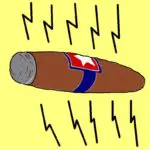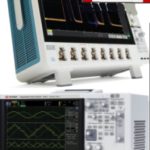Liquid Instruments, an Australian company (there is also a U.S. office near San Diego), is offering a new diagnostic and product development tool that enhances the ability of laboratories and educators to see ever deeper into waveforms of interest.
Previous instruments were Moku:Lab and Moku:Go. While these units were robust diagnostic engines, Moku:Pro puts it all together in an intuitive benchtop array that will find a place in electronic labs and diagnostic facilities everywhere.

As a demonstration, Moku:Pro can be connected to a user-supplied benchtop oscilloscope and to a stand-alone arbitrary function generator. From the AFG, run two BNC cables to two of the Moku:Pro input ports on the left and from Channel One in the oscilloscope, run a third BNC cable to one of the Moku:Pro outlet ports on the right. In the AFG, choose one of the internal waveforms and it will display in the oscilloscope. Here for now the Moku:Pro is performing a passive role, simply conveying the signal from the AFG to the oscilloscope.
The Moku:Pro is intended to be used with a Mac iPad, which the manufacturer includes. (The Moku:Lab also uses an iPad for control and display functions. The Moku:Go, designed primarily for student use, works instead with a Mac or PC laptop.) The iPad controls the Moku:Pro, displays the signals, and in fact is an integral part of the instrumentation. It receives the software that is downloaded from Liquid Instruments’ website, subsequently transferring it to the Moku:Pro. The iPad touchscreen is the user interface. If you are not a pre-teen with extensive knowledge of such things, working the iPad can be the more challenging part of the procedure.
The challenge for Liquid Instruments has been to combine the great number of measuring instruments into a single box that could perform many of these functions strictly according to software. As first launched in 2014, the single box consisted of three instruments, oscilloscope, phasemeter and spectrum analyzer. The ensemble is known as software-defined hardware. At present, one device can function as any of twelve stand-alone measuring and display instruments.
The Moku:Pro, in conjunction with the iPad, contains these instruments:
Lock-in amplifier
Oscilloscope
Waveform generator
Spectrum analyzer
Digital filter box
FIR filter builder
Arbitrary waveform generator
PID logger
Logic analyzer/pattern generator
Laser lock box
A Moku:Pro configured with all the above instruments and a 12.9-in iPad Pro is called a full suite. There is also a build-your-own suite available for a lower price point where the user selects five of the above instruments and which includes an 11-in iPad Pro. Accessories consist of a 500-MHz, 1.3-m-long DUT connection probe that sports a 300-V input voltage, 10 MΩ/9.5 pF input impedance, and will support a 700 psec risetime.
A lock-in amplifier can extract a signal with a known carrier wave from a noisy environment. Signals up to a million times smaller than noise components, potentially at nearby frequencies, can be detected. In contrast to previous lock-in amplifiers that use analog frequency mixers and RF for demodulation, the latest lock-in amplifiers implement both steps by fast digital signal processing, as in an FPGA.
A digital filter performs mathematical operations on a sample discrete-time signal. It can either enhance or reduce certain aspects of the signal. This is distinct from an analog filter. In high-performance applications, an FPGA or ASIC is used rather than a conventional microprocessor. Digital filters are widely used in modern radios, cellphones and AV receivers.
A logic analyzer is capable of capturing and displaying multiple signals from one or more digital circuits. It may convert the data into timing diagrams, protocol decodes, state machine traces, assembly language or it may correlate assembly with source-level software. These instruments have advanced triggering capabilities and are valuable for users who want to view the timing relationships between multiple signals in a single digital system.
A pattern generator may take the form of either hardware or software. It is used to generate digital electronic stimuli to be applied to electronic equipment or circuitry to facilitate product development or diagnosis. The digital pattern generator can produce either repetitive or single-shot signals, in which case an internal or external triggering source is required.
The technology for Moku:Lab and its successors was inspired by the Field Programable Gate Arrays (FPGAs) employed in the first attempts at gravitational wave detection. Moku:Lab, the first of the three precision measuring devices, emerged from this work on the LIGO project. Basically, it is a single device containing a powerful FPGA. FPGAs have three aspects making the device important in the Moku:Pro. The first of these is a lot of processing power–for example, the Xilinx Ultrascale+ employed in Moku:Lab provides 64-bit processor scalability while combining real-time control with soft and hard engines for graphics, video, waveform, and packet processing. And of course, FPGAs are completely reconfigurable and field programable.
Liquid Instruments in the U.S. is at 740 Lomas Santa Fe Dr. Suite 102, Solana Beach, CA 92075, (619) 332-6230. In Australia, 243 Northbourne Avenue Suite 2, Lyneham, ACT 2602, +61 2 6171 9730.






Leave a Reply
You must be logged in to post a comment.